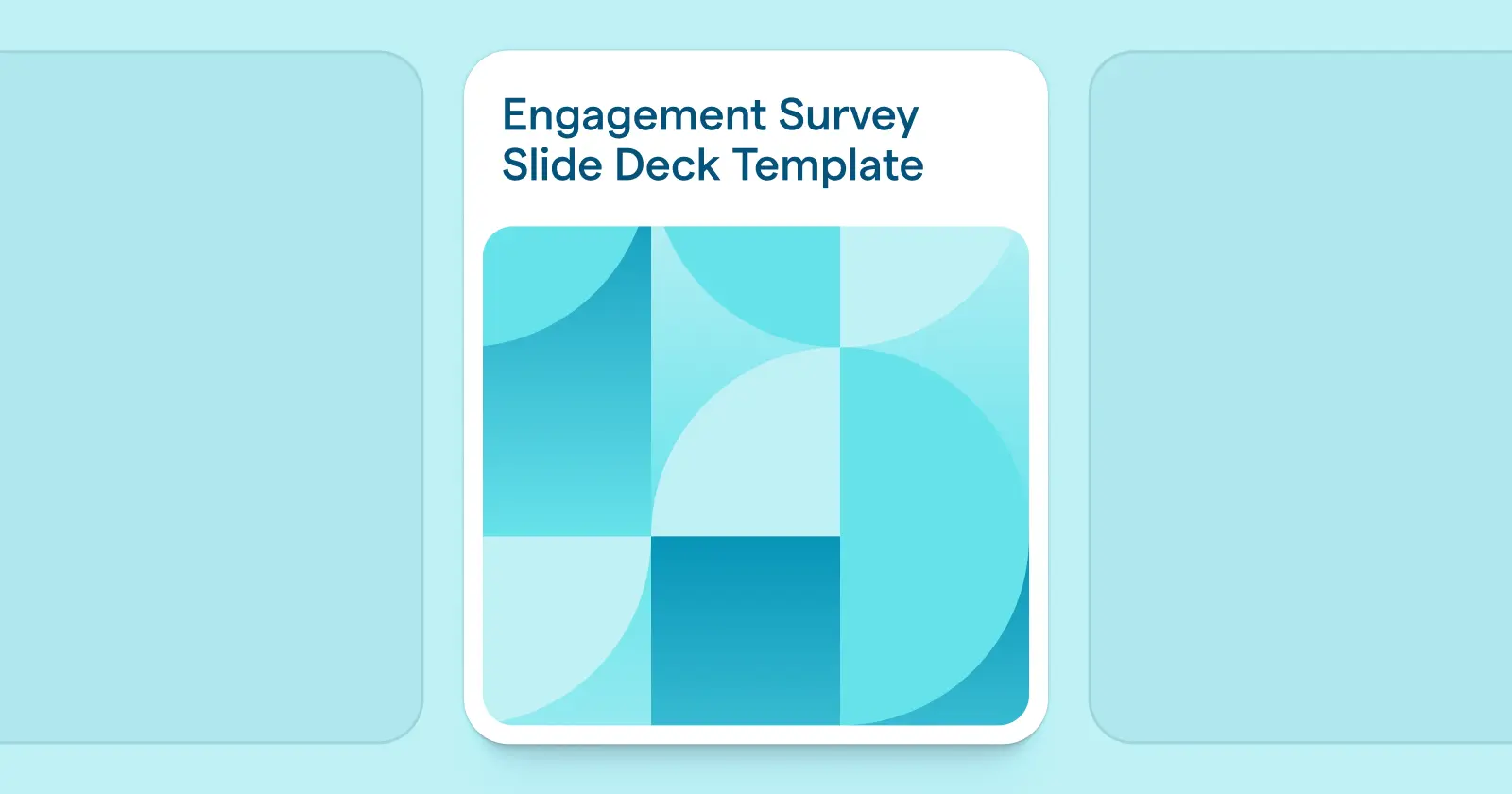Employee engagement in the US is at a ten-year low, according to Gallup. And it’s not because HR teams aren’t trying. In our 2026 State of People Strategy Report, 39% of HR teams said employee engagement is a top priority for the coming year.
The struggle seems to be taking meaningful action, and a big part of the problem is resourcing. In our survey, 39% of HR teams said senior management views engagement as important, but not a strategic priority at their company. Plus, 41% of teams say they’re under pressure to justify engagement initiatives.
But there are still steps you can take — ones that don’t require a months-long campaign to get leadership buy-in. You can focus on the part you can control: turning employee feedback into something visible, specific, and real.
This guide will walk you through how to do exactly that: analyzing your survey results with Lattice’s AI-powered tools, setting team-level goals, building buy-in, and keeping momentum going.
Why You Need an Effective Employee Engagement Action Plan
Running an employee engagement survey isn’t the hard part. Most human resources teams have that process down. The real challenge is what comes after.
Without follow-through, surveys can actually backfire. If employees take the time to give honest feedback and don’t see any changes, they may feel like their voice doesn’t matter.
And feeling valued is key to engagement. Gallup’s research found the recent drop in engagement was accompanied by fewer employees feeling cared about at work. In 2024, 39% of employees strongly agreed that someone at work cared about them, compared to 47% in March 2020.
The whole purpose of running engagement surveys is to make employees feel heard. But listening alone isn’t enough. Without a clear plan of action, even the most thoughtful survey can fall flat. Employees don’t just want to feel that you’re listening; they also want to see that their feedback leads to something real.
You don’t need to solve everything at once. The key is to focus on a few high-impact engagement goals and communicate your intentions clearly. Be transparent about what you’re prioritizing and why.
Then, take visible steps. Even small changes signal that leadership is paying attention.
Because when employees see that their feedback leads to action, they’re more likely to stay engaged in the process. They’ll keep responding to surveys. They’ll keep speaking up. And over time, that creates a work environment where listening and acting go hand in hand.
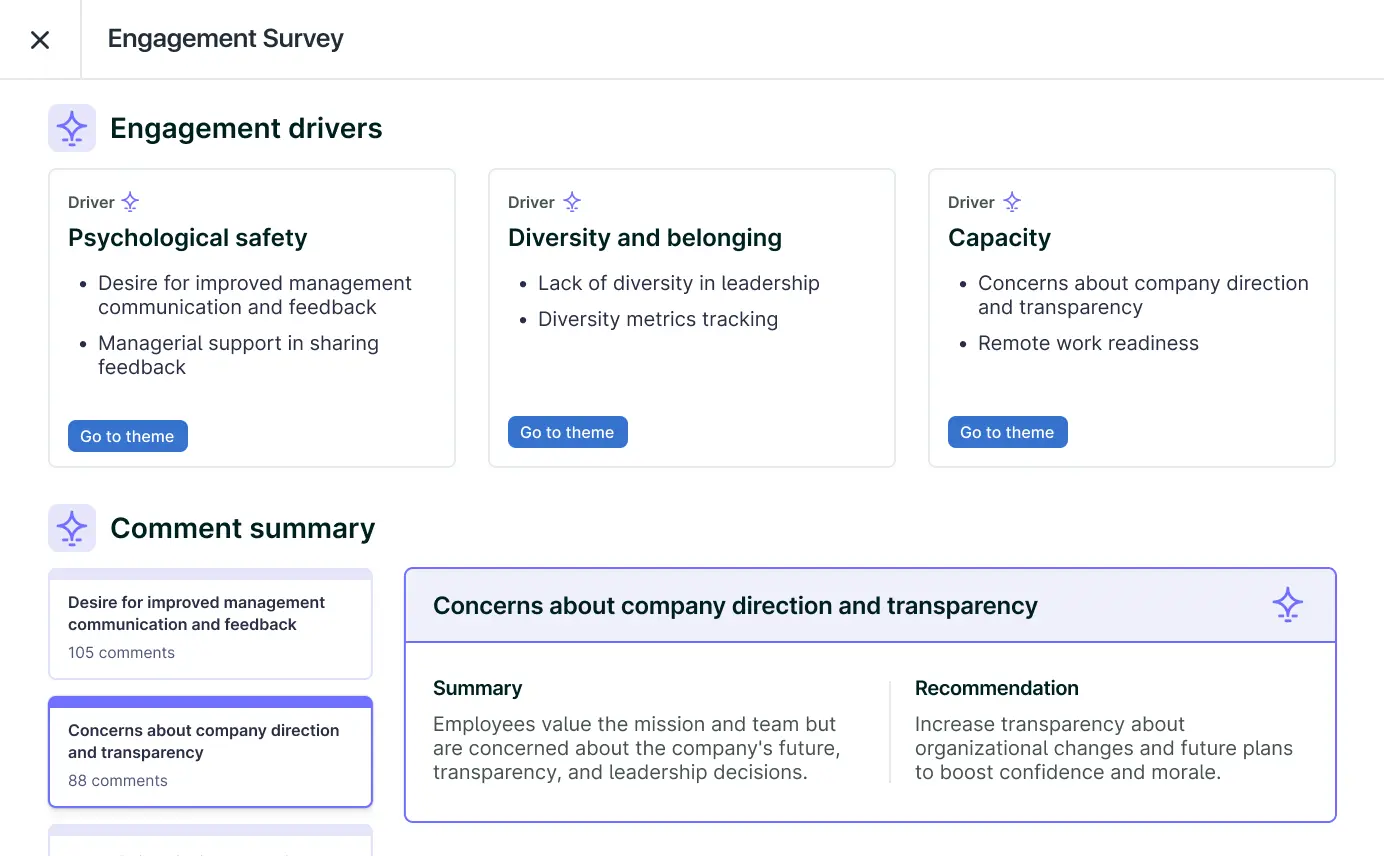
Step-by-Step: How to Create an Engagement Action Plan
Building a meaningful employee engagement strategy from your engagement data isn’t about checking boxes. It’s about making real, measurable progress on the issues your employees value. Here’s how to approach it, one step at a time:
1. Start with the right questions.
A successful action plan begins with the survey itself. The survey questions you choose shape everything that comes next.
As Gillian Heltai, Lattice’s former chief customer officer, now COO of Haus, put it in our webinar on engagement surveys, “You don’t want to set yourself up for failure.” She advises avoiding questions you can’t realistically address.
For example, if your company is locked into a 10-year office lease, asking about satisfaction with the physical location won’t lead to meaningful change. Instead, it risks surfacing frustration you’re not in a position to fix.
Use the survey as a foundation for action, not just insight.
{{rich-highlight-4}}
2. Analyze the results.
Once you’ve collected responses, the next step is interpreting them with care. To uncover meaningful insights into employee engagement levels, you’ll need to dig deeper than the top-line scores. Here’s how:
Break down the results.
Start by looking beyond company-wide averages. Slice the data by department, location, tenure, job level, and other key demographics. Comparing cross-sections helps you understand where engagement varies and why.
Read the comments.
Open-text responses offer valuable context. Look for repeated themes and tone shifts. Tools like Lattice’s sentiment analysis can help you quickly identify what employees are really saying and feeling.
Look at trends over time.
Track engagement across multiple surveys to spot improvements or declines. Measuring employee engagement over time also helps you account for seasonal shifts in sentiment and measure the impact of past initiatives.
Benchmark externally.
Compare your scores against industry peers to determine where you stand. Just be mindful of response rates and sample sizes when interpreting the data.
Visualize the data.
Charts and dashboards can bring trends to life in a way spreadsheets can’t. Use visuals to highlight differences across teams or spotlight emerging issues.
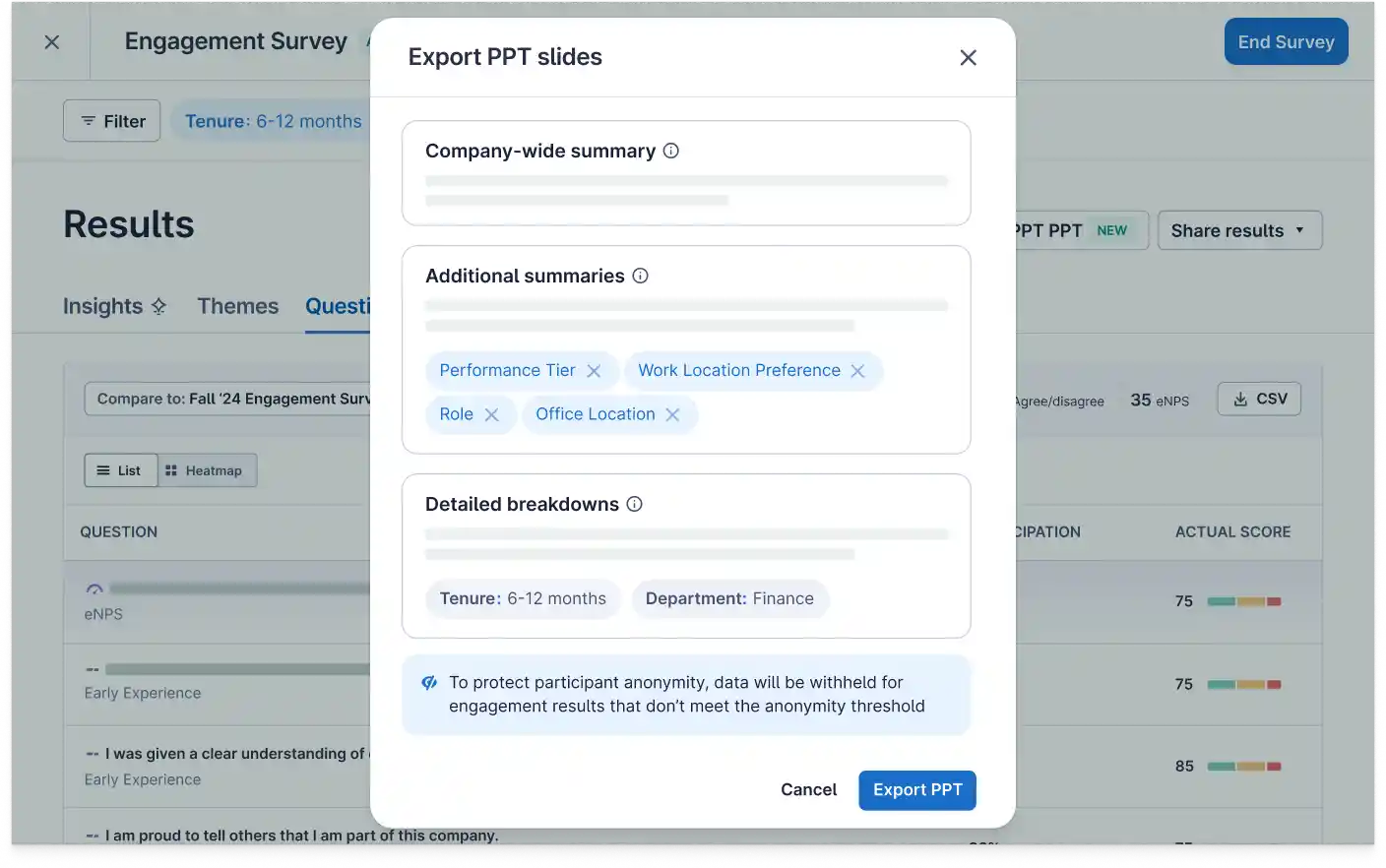
Analyzing engagement data takes some effort, but it’s the first step toward making real change. Lattice’s natural language processing (NLP) tools help you spot themes, patterns, and potential blind spots quickly and accurately.
3. Share findings with leadership.
Once you’ve reviewed the data, it’s time to bring leaders into the loop and build momentum for action.
Start with the why.
Remind your audience why the survey matters. Link engagement to business outcomes like productivity, retention, and performance. If you asked about belonging or employee Net Promoter Score (eNPS), connect those results to broader talent and workplace culture goals.
“The key is to clearly articulate the impact of employee engagement on business needs, and to do so in a language that reinforces your leadership team’s priorities,” explained Melanie Naranjo, chief people officer at Ethena, in our 2025 State of People Strategy Report.
“You need to connect the dots for your CEO. Just because HR leaders know that low employee engagement leads to lower productivity, missed business goals, and less revenue for the company, doesn’t mean your CEO understands it, too. Instead of just saying, ‘Employee engagement is down, and we need to fix it,’ explain the impact of low employee engagement on the core business priorities.”
Set expectations around participation.
Show how many employees completed the survey and where response rates were strongest or weakest. Keep in mind that extremely high response rates can sometimes signal that employees felt pressured to respond. This can indicate cultural issues — like low psychological safety or fear of repercussions — that leaders should address before drawing conclusions or acting on the data.
Highlight key takeaways.
Walk through the main themes. Where did you successfully drive engagement? Where did scores drop? Use benchmarks, historical comparisons, and team-level breakdowns to provide context.
{{rich-highlight-3}}
Explain the “why” behind the numbers.
Dig into specific question responses and demographic patterns. Share standout comments to add color and use visual tools like heatmaps to spotlight trends across departments or roles.
This conversation is the bridge between survey results and action items. When leaders understand the insights, they’re more likely to support the next step: building a thoughtful, targeted action plan.
4. Set your focus.
Once you've shared your findings with key stakeholders, the next step is deciding what to act on. Even if your engagement scores were strong overall, there’s always room to do better. But trying to fix everything at once can dilute your impact.
Start by narrowing in on the most important areas. A simple strengths and weaknesses matrix can help here.
From there, pick a few key weaknesses to prioritize. One to three is a good number. More than that, and it can become hard to maintain momentum. Some common issues include:
- High levels of absenteeism
- Low levels of wellbeing
- Issues with work-life balance
- Demand for more flexible work options
- Concerns about poor onboarding programs for new hires
- Complaints about a lack of professional development opportunities or employee recognition programs
- High levels of burnout
For each area, start brainstorming potential solutions to boost morale. These don’t need to be fully fleshed-out goals yet, just a clear starting point. Here’s an example:
- Weakness: Customer success teams struggle to get insights from sales. The team handoffs are getting messier as we scale up.
- Potential Solutions: We could encourage sales and CS leaders to agree on what information matters most during the transition from prospect to customer. Creating a shared customer brief or hosting a regular sync could help both teams stay informed and improve the customer experience.
- Why This Helps: This step is about turning raw data into direction, so when it’s time to set goals, you’re not starting from scratch.
5. Define concrete actions.
Once priorities are clear, it’s time to map out the next steps. The more specific you can be, the easier it will be to follow through. Work with leadership and managers to translate priorities into SMART goals, and assign ownership, timelines, and milestones.
Lattice’s AI-generated action plan playbooks can help jumpstart planning around common themes like growth, recognition, or communication.
And, if you’re looking for more inspiration, head over to our guide 13 Employee Engagement Activities for Modern Teams.
6. Communicate transparently.
It’s key that you share both your engagement survey results and your action plan with the wider company. Presenting them together shows employees that their feedback is driving real, concrete change — and it helps reinforce accountability across the teams responsible for follow-through.
“The best tool for driving action is visibility, because visibility creates pressure,” explained Heltai.
{{rich-highlight-1}}
Employee Engagement Strategy: Common Pitfalls to Avoid
Even well-run surveys can fall short if the follow-through isn’t there. Below are some of the most common engagement pitfalls — and how Lattice can help you avoid them.
Pitfall #1: Over-Promising and Under-Delivering
When you commit to solving everything at once, expectations rise fast — and so does employee disappointment if change doesn’t happen.
Lattice’s AI-powered action planning generates custom recommendations and best-practice playbooks for focus areas like morale, career development, and team alignment. It helps you focus your efforts where they’ll make the biggest impact.
Pitfall #2: Delaying Action After the Survey
Letting feedback sit for weeks can really erode employee trust. Employees want to see that their input matters — and quickly.
Lattice Engagement uses AI to instantly identify key themes, strengths, and gaps. You’ll also get auto-generated, downloadable presentation slides to help you share results without delays.
Pitfall #3: Treating Action Planning as a One-Time Project
Engagement isn’t a set-it-and-forget-it initiative. Without ongoing effort, initial progress stalls out.
Lattice Pulse makes it easy to follow up regularly with targeted surveys. Monitor how things are tracking and adjust as needed — no need to wait for the next annual survey.
Pitfall #4: Focusing Only on Company-Wide Trends
Topline results are helpful, but they often mask team-level challenges. Without that detail, managers can’t take informed action.
Lattice Analytics breaks down data by team, department, and demographic. And HR teams aren’t the only ones who get these results. With Lattice Analytics, every manager gets AI-powered insights they can use to improve the employee experience.
Pitfall #5: Not Linking to Development
If survey insights don’t inform your growth and development program, you miss a major opportunity to support your people. Engagement and development are closely linked: Our 2025 State of People Strategy Report found that learning and development (L&D) programs were the most popular engagement strategy.
Lattice Grow ties engagement insights to personalized development plans. And Lattice 1:1s and Updates ensure that progress stays on the radar in regular manager check-ins.
With the right tools in place, the action planning process doesn’t have to feel overwhelming. You can move quickly, stay focused, and make meaningful progress — without burning out your team members.
{{rich-highlight-2}}
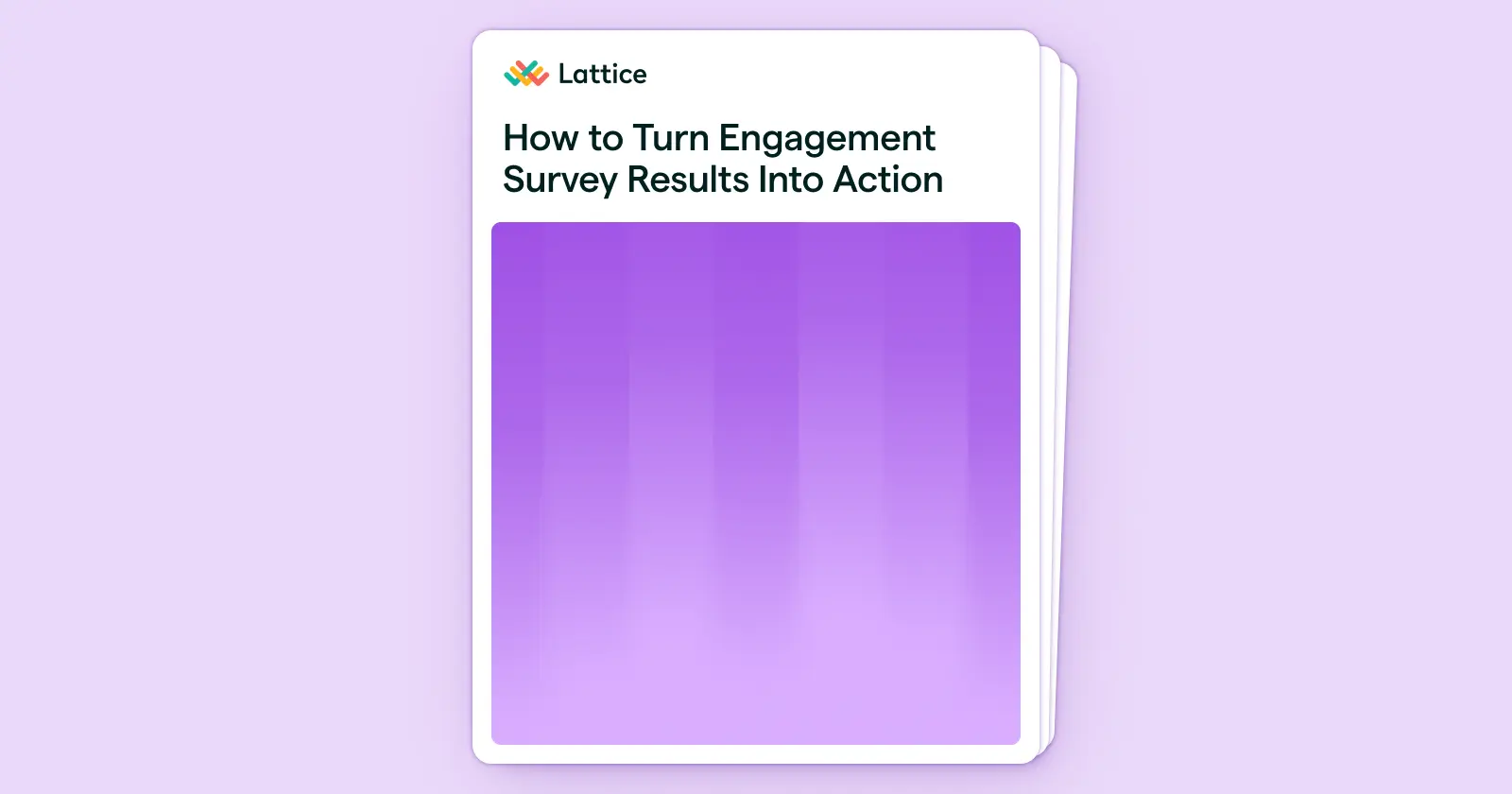
Your results are in. Now what?
Want help crafting action plans that your teams can actually execute? Download our ebook, How to Turn Engagement Survey Results Into Action.
Turn insight into impact with Lattice.
Taking action on engagement survey results is one of the most meaningful ways to build trust with your employees, but it can also feel overwhelming. From analyzing open-text responses to getting stakeholders on board and setting goals, there’s a lot to manage.
That’s where Lattice comes in. Our AI-powered engagement tools surface key insights, recommend proven next steps, and help you keep momentum across the company.
Ready to turn employee feedback into lasting change? Request a demo of Lattice Engagement.
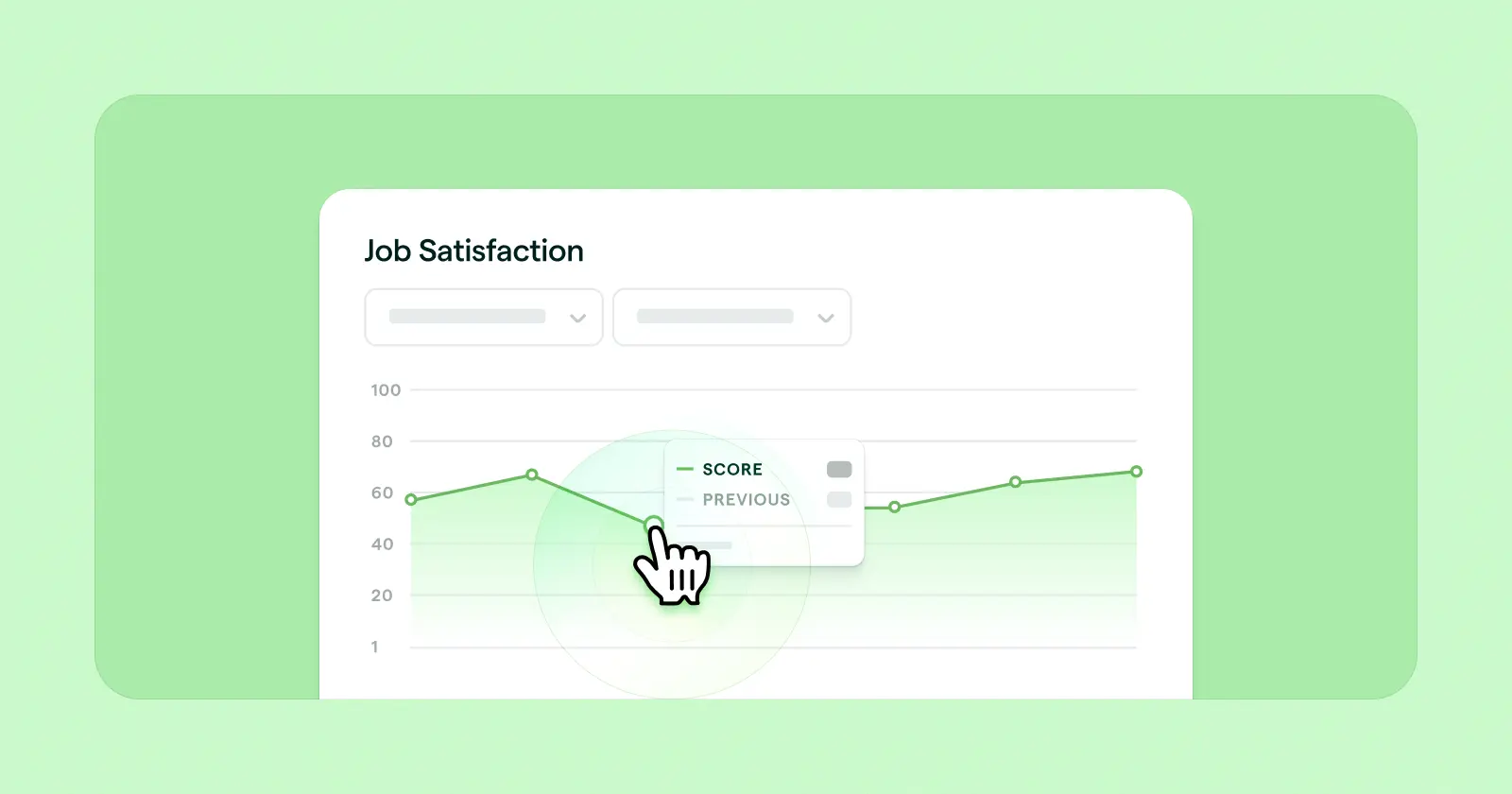
Take Lattice Engagement for a spin.
Stuck making surveys by hand? See how Lattice Engagement can help you collect feedback, automatically surface AI-powered insights, and implement programs that improve productivity and retention.


